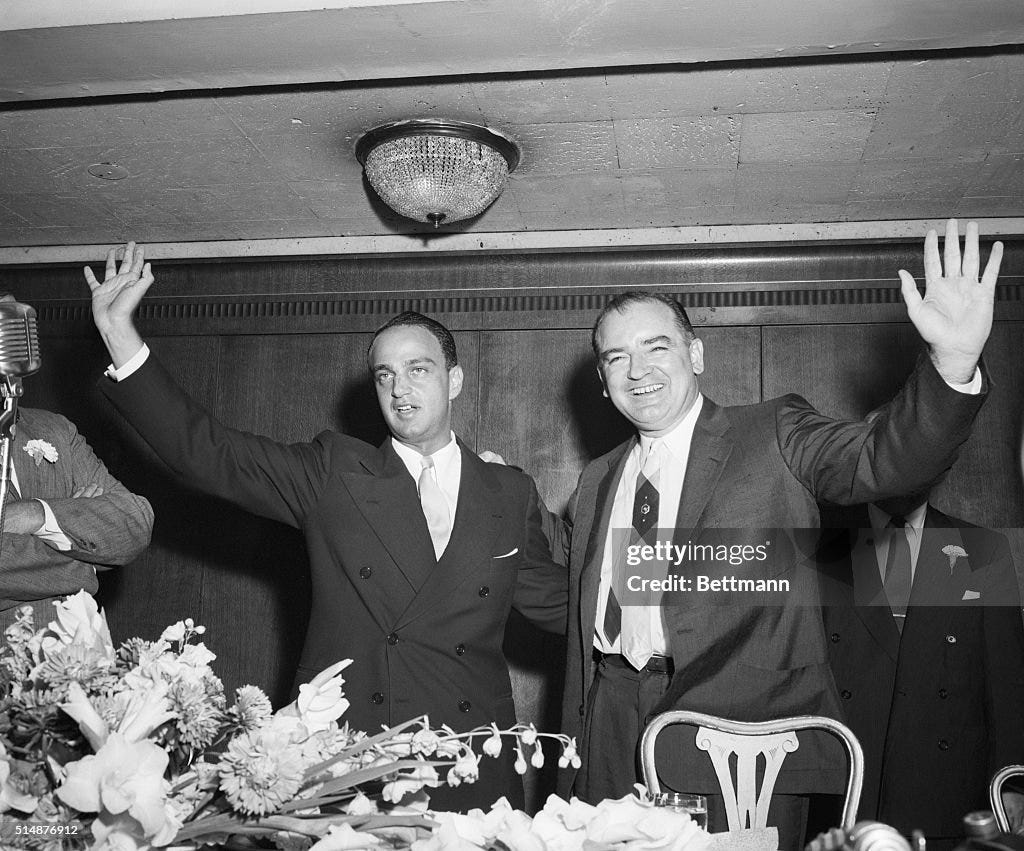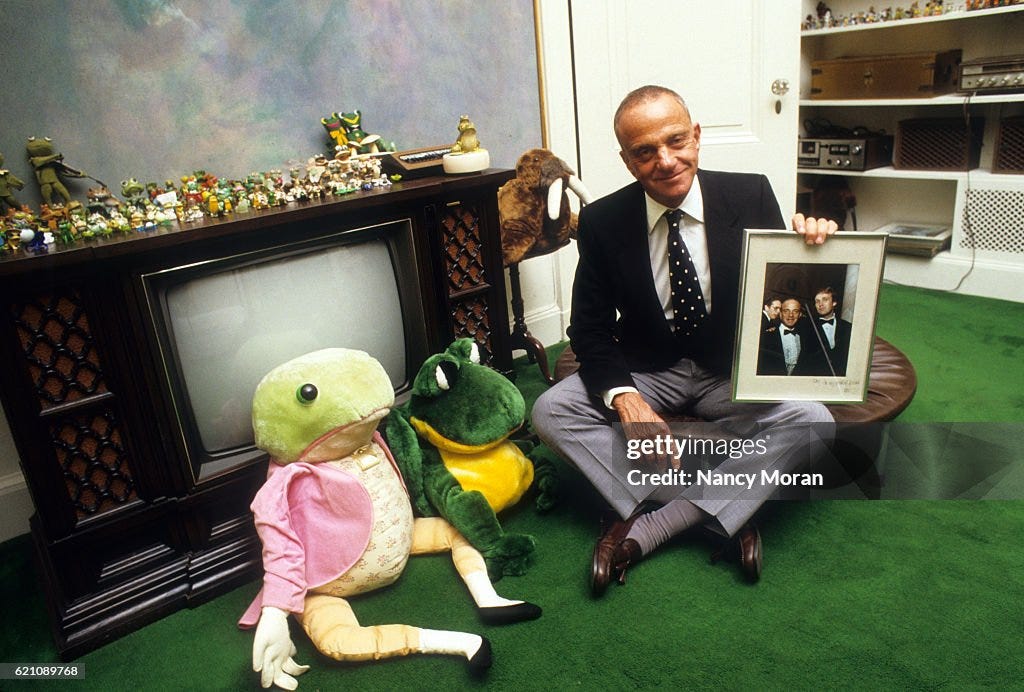Emily "I Fucking Told You Bitches So!!!!!!!!!" For President
This is actually a pretty scholarly piece so I hope you read it and walk away from it having learned something new...bitch
I’ll admit it’s getting a little hard to focus on just one thing to discuss each week. I have to simply because I refuse to be bested by the re-animated drowned river corpse of Steve Bannon, but know that sometimes, I might not pick the most important topic—I’m just picking one.
This week, I wanted to revisit a conversation we’ve already had from a new, more mature, more focused angle. I just want to prepare you for the fact that we’re talking about Roy Cohn again. That’s what we’re all about here at Emily For President talking about Roy Cohn again: learning, growing, evolving, talking about Roy Cohn yet again. I am so sorry but unfortunately, we’re talking about Roy Cohn again.
Last weekend, I bullied my parents into watching The Apprentice film, which, understandably, no one wanted to see this movie with me when it came out in October, but as I’ve discussed here and elsewhere, I was floored by its factual accuracy. I knew it was an entertaining way to convey a lot of the history I’ve been swimming in for the last seven years since I started studying Roy, and it very clearly showed the psychological fuckery that has made Donald Trump the strongman he is today.
When we talked about Roy last August, the tone was a little bit lighter and sillier because, candidly, parts of his story are objectively silly. But we also weren’t living under a Trump Administration at the time so there wasn’t as much need to be so serious about these things. Returning to the film last week and seeing my parents’ reactions to it—when it ended, my mom announced that everyone needs to see this movie but she will never watch it again—I realized how much merit there is in talking about the worst parts of Roy and how we’re still feeling his impact today.
In other words, I’m re-arguing my college thesis.
Today, we’ll look at how Roy shaped Trump’s approach to loyalty, America, and the truth to better prepare ourselves for whatever fresh horror tomorrow brings. I’ll also include some of what I know about the histories and ideologies Trump is building upon. In school, I was taught that the best way to prove your argument was to understand and disprove your opponents—this is my attempt at that.
LOYALTY. FEAT. DONALD TRUMP.
Upon re-reading the piece on Roy from August, I realize now I buried one of my favorite and the most important facts about his relationship with Trump in a wordy soup. I’m about to do the exact same thing again, but I wanted you all to know that I know I also did it in August.
In 1947, President Harry Truman signed an executive order establishing a loyalty program “designed to root out communist influence in the U.S. federal government” (X). It was the dawn of the Cold War and, as we’ve covered here before, Americans were growing increasingly worried that subversives—or, Communist spies living as normal Americans while seeking to overthrow democracy, and their supporters—had infiltrated the country.
Executive Order 9835 “allowed the FBI to research whether the name of any of 2 million federal employees raised questions about their associations and beliefs and, if ‘derogatory information’ was found, to follow up with a field investigation” (X). Prospective employees who applied to work for the government after the order was passed would also be checked for any disloyal behavior.
Disloyalty was generally defined by acts of espionage, “sedition or the advocacy thereof, intentional, unauthorized disclosure of confidential information, advocacy of the violent overthrow of the U.S. government,” or any ties to organizations “labeled as totalitarian, fascist, communist or subversive” (X).
Sound familiar?
Anyway, according to historian Robert H. Ferrell, “By mid-1952, when more than 4 million people, actual or prospective employees, had gone through the check, boards had charged only 9,077, brought 2,961 to hearings, and dismissed or denied employment to 378—.002 percent of the total. None of the discharged cases led to discovery of espionage.” In other words: there was no subversive network threatening to topple the US Government from the inside. Nevertheless, the “Loyalty Order” created an environment so hospitable to fearmongering.
Paranoid people tend to do well in situations like this, where everyone is an enemy until proven otherwise. After using his relationship with Judge Irving Kaufman to secure a death penalty sentence for both Julius and Ethel Rosenberg, Roy Cohn was convinced Communists had bugged his office to retaliate. A few years later, during the Army-McCarthy Hearings, it came to light that “at some point during his time as McCarthy’s chief counsel, ‘an oath of loyalty to Cohn was signed by the staff of the McCarthy Subcommittee.’”1
I say all this because, if you’ll recall, in 2017, then-Director of the FBI James Comey met with Trump shortly after his first inauguration to discuss the contents of the dossier assembled by a former MI6 agent, Christopher Steele.
Comey decided to request a one-on-one session with the president following the large meeting to discuss the salacious information the Steele dossier contained in a more private setting…Comey knew that the information, being both unclassified and dramatic, would likely surface in the press soon and tried to make that clear to Trump in order to help the incoming leader brace for its impact. While the interaction was intended to communicate valuable information and assistance, Trump perceived the meeting as an affront to his legitimacy…
Following the interaction, it became clear that the president considered Comey to be his enemy and his distrust prompted Comey to begin composing memos documenting his impressions of their interactions. Comey’s second memo recorded a surprise February dinner between the two at the White House when,
“at one point during the conversation, Trump stated that he needed loyalty and expected loyalty, and then later stated again ‘I need loyalty.’ Memo 2 reflects that the second time Trump stated his need for loyalty, Comey responded that the President would always get honesty from Comey... Memo 2 also notes that it was possible that Comey and Trump ‘understood that phrase differently’ but that Comey ‘decided it would not be productive to push the subject further’” (X).
Loyalty, to Roy, was a two-way street, mainly because everything was transactional to him. But it was also shaped by his earliest experience with betrayal, watching his father betray and be betrayed during his tenure as a New York Appellate Court judge.2
One thing The Apprentice succeeded at is showing how much influence Roy directly has on who Trump is today. Everything Trump now knows today about loyalty was taught to him by Roy…but Trump is failing an open note test. His narcissistic spin on Roy’s rules has led him to interpret loyalty as something pledged solely to him. This is how you get the James Comey of it all, but it’s also how Trump has built his current administration.
While Executive Order 9835 was subsumed by Executive Order 10450 in 1953 and later repealed in 1995, most federal employees in the years since 1947 have still operated under the practice of not betraying or destroying the government, even political appointees. And, funny enough, most still do—or did until they were fired over the past month. While you can fundamentally differ in political beliefs from cabinet members of yore—and believe me, I really fucking do—the majority of them have wanted to commit their evils within the limitations of checks and balances (Mark Meadows, eat shit).
With this new administration, Trump has taken the worst of Roy’s worst and somehow finds a new rock bottom every day. When you call yourself a king while surrounded by glassy-eyed sycophants who would follow you to Jonestown or Greenland if you asked, that is not loyalty—that is a cult. This makes sense, in a way, as Trump never truly learned how to be loyal to anyone, not even Roy.
But there is something to be said for the people currently destroying our government in the name of “saving” it. It does all of us, these seditionists in office included, a disservice to write them all off as simply evil or stupid. They are operating from an ideological framework that has come together over the last 80 years…that is evil and stupid.
Are You There, God? I Need You to Ask Satan to Give Phyllis Schlafly a Message From Me
Historically speaking, there is some critical thinking behind the sentiment “Make America Great Again,” though whether or not Donald Trump was one such person who did so is still up for debate.
By 1959, the Second Red Scare was largely considered to be in decline, but
while the fever of anti-communism began to dissipate following McCarthy’s censure…the fear of subversives that he and Cohn had cultivated remained. In the immediate post-war years, at a time when security and stability were no longer certain, there was a growing desire to preserve “the way things were” prior to World War II. As such, the 1950s saw an entrenchment in rigid societal norms and conservatism became a mentality of the past, advocating stagnation for the sake of security and the preservation of privilege.
But as historian Corey Robin explains in his book, The Reactionary Mind, “modernity has seen too much flux to sustain a belief in hereditary status. The watermarks of privilege and privation are no longer visible to the naked eye; they must be identified again and again, through struggle and contest.” In the relative calm of the latter half of the 1950s, the want for change began to grow. The 1960s exploded with societal shifts headed by a dissatisfied, liberal youth who wanted more—more civil rights, more social mobility, more independence in general. Thus began the counterculture, an age of unrest in which conservatives faced their greatest opposition (X).
If you ask a MAGA supporter when America was great, you’d inevitably hear a variety of answers because, to my knowledge, Trump has never given a particular date when things were great. And yet, the concept of MAGA—sorry, LMAGA—has been regurgitated since Ronald Reagan’s 1980 presidential campaign so clearly it holds some kind of hold on conservative voters…but why?3
As stated above, by the 1960s, conservatives had already started claiming the 1950s were the period to return to. Despite the persistent fear of an internal subversive attack and a lack of confidence in national security following the invention of nuclear weapons, the counterculture of the 1960s and 70s led post-war conservatives to tie the desire for change to the potential societal collapse:
To many conservatives, those trying to fight for greater equality in the 1960s were really advocating for an overthrow of American society, calling once more on the fear of subversives. By and large, “the modern right wing...[felt] dispossessed: America [had] been largely taken away from them and their kind, though they are determined to try to repossess it and to prevent the final destructive act of subversion.”
…The nuclear family—which became shorthand for heteronormative, racially homogeneous, monogamous marriages resulting in multiple children—served as a microcosm for the conservative socio-political structure with a patriarch functioning as the head of the governing body with a wife and children existing as subservient citizens inside their own home. This structure made conservatives nostalgic for a mythical “better time” prior to liberal movements.
While there has never been a stagnant period in American history, the 1960s were an era of constant change and by controlling the family, conservatives felt they too could return to a position of control over the government and society (X).
As we learned from Ellie Light a few weeks ago, conservative voters “are focused on how things immediately impact the people around them...They essentially think and act locally and expect the same of others.” By intertwining the body politic with the concept of the nuclear family, post-war conservatives came to see change as an attack on their safety and way of life which is a concept we can still see in contemporary conservative ideology.
The mental gymnastics to prove these points is exhausting but I think the gaps in the logic can very simply be filled by reminding us all that “this country” “was originally found” “by” “and for” land-owning white men. Conservatives have long since claimed the Founding Fathers, the Constitution, and the start of America as part of their brand. If your entire ethos glorifies a time when all of the power was consolidated into the hands of such few, no shit you’re going to freak out when people start demanding equal rights! That’s the opposite of everything you stand for!!!
You can see this in the talking points of conservatives throughout post-war history like Phyllis Schlafly, Candace Owens, and *gasp* Roy Cohn. These are people who were and are so obsessively committed to maintaining a hierarchy that actively oppressed or oppresses them that they don’t recognize the irony of their beliefs. They advocate for their own subservience…with the freedoms offered to them by the people they claim are ruining the country…that their subservience means to protect.

Look, I meant everything that I said three weeks ago but I also simultaneously believe that conservatism never has and still does not make any fucking sense. McCarthyism, conservatism, and now Trumpism have always been this amuse-bouche of regressive beliefs that supporters cling to in the name of preserving a version of this country that has never existed exactly as they say it did. These three ideologies have built around each other like a turkey around a duck around a chicken, and the turducken sum of their parts is this earnest belief that America is greatest when it is a place for the few rather than the many—or, perhaps more accurately, for the many at the discretion of the few.
Trump learned all of this—the historical cognitive dissonance, the hierarchy of entitlement to living in America, the being a real piece of shit—from Roy. Roy Cohn is responsible for ruining and ending countless lives in the name of preserving America’s greatness, for the betterment of himself. Roy taught Trump that if you tell yourself and others the same story over and over again, like that you alone are making America great again, anything can become the truth.
The Truth Is a Wish Your Heart Makes
The great thing about The Apprentice movie is that it’s hard to spoil much because, by and large, this is all historical record. However, to segue into the final section, I need to discuss the final scene from the film. If you want to get there on your own, spoiler-free, skip down three paragraphs.
In the final scene of The Apprentice, Sebastian Stan’s Trump is sitting down with Tony Schwartz in Trump Tower to discuss what will become The Art of the Deal. Roy Cohn has died, Trump has undergone a fat removal procedure and a scalp reduction to fix a bald spot, and greed is good…allegedly. As they try to build a narrative for the book, this Trump starts lying about things we’ve watched unfold over the past hour and 54 minutes. Then he starts to share his three rules:
Rule one: the world is a mess. Okay? The world is a mess, Tony. You have to fight back, you have to have a tough skin. Attack, attack, attack. If somebody comes after you with a knife, you shoot him back with a bazooka. Okay?
Rule two: what is truth, Tony? What is truth? You know what’s truth? What you say is truth, what I say is truth, what he says is truth—what is the truth in life? Deny everything, admit nothing. You know what’s true? What I say is true.
And third of all, the most important: no matter how fucked you are, you never, ever, ever admit defeat. You always claim victory. Always.
This, too, is another lie as these aren’t his rules but Roy’s that he’s repurposed and repackaged like a shitty hotel next to Grand Central. In reality, Cohn’s rules were, notoriously, “‘1. Never settle, never surrender. 2. Counter-attack, counter-sue immediately. 3. No matter what happens, no matter how deeply into the muck you get, claim victory and never admit defeat’” (X), close enough cousins of those in the movie to skirt any intellectual property infringement.
In a way, all of these rules—both the real ones and their fictionalized versions—speak to the idea of controlling the narrative and therefore controlling the truth. We can see this in every element of Trumpism and Trump himself, and it is especially clear in how he views loyalty and America (oh my, she’s really tying the whole piece together now). We see already how keeping only his devotees close has changed the tone of this administration; how they’re able to say and do whatever shit they want because, well, they were mandated to act this way; how Trump is the law of America.
You truly can’t help but see Roy in the way Trump approaches the truth: Roy was disbarred for being dishonest but also lived his life dishonestly. He used his connections with columnists and reporters to control his reputation, namely to live “‘in a closet with neon lights.’”
It is fascinating to see the lengths Roy went to create a specific narrative around his sexuality. In an Esquire interview with journalist Ken Auletta, in an exchange between Roger Stone and Jeffrey Toobin, and in Tony Kushner’s Angels in America, we see nearly the exact same refrain:
When journalist Ken Auletta interviewed Cohn in 1978, he made a point of telling Cohn the number of people who asked Auletta: “‘Do you know that Roy is a homosexual?’” As Auletta’s tapes show, Cohn takes a long pause before launching into an explanation as to why homosexuality is not compatible with his aggressiveness (X).
…in a 2008 interview with Roger Stone, the Cohn mentee sharply claimed that “‘Roy was not gay... He was a man who liked having sex with men. Gays were weak, effeminate... He was interested in power and access’” (X).
Many of Cohn’s most problematic convictions define his character in the play, such as in Act 1, Scene 9 of Millennium Approaches when Cohn’s doctor gives him his AIDS diagnosis and the following ensues:
ROY: ... I have sex with men. But unlike nearly every other man of whom this is true, I bring the guy I’m screwing to the White House and President Reagan smiles at us and shakes his hand. Because what I am is defined entirely by who I am. Roy Cohn is not a homosexual. Roy Cohn is a heterosexual man, Henry, who fucks around with guys.
HENRY: OK, Roy.
ROY: And what is my diagnosis, Henry?
HENRY: You have AIDS, Roy.
ROY: No, Henry, no. AIDS is what homosexuals have. I have liver cancer (X).
What’s even more fascinating than this public record of Roy’s best efforts at controlling his image, based on the personal accounts of his last boyfriend, Roy knew none of this was the truth.4 More to it, when the loyalists stopped helping Roy and his status as a gay man dying of AIDS in America in the 1980s became known, we all knew it, too.
I found that the final scene of The Apprentice film argues the same thing I did towards the end of my thesis which is that Trump is no longer Cohn’s mentee but his successor. (Granted, Roy Cohn was and will never be president so the comparisons between the two will always be off-balanced.)
This might be a fruitless and naive way to conclude all of the history I’ve studied and the parts of it I’ve managed to share here but it always brings me a little comfort to remember that Roy, like most villains, didn’t win in the end. People are and will continue to suffer under this new Trump Administration the way they did under Roy’s thumb, and no amount of history lessons seem to be able to stop that. But if all the ways Trump the successor mirrors Roy mean anything, maybe it’s that the hatred and the anger and the fear that has driven both men can only burn for so long before they give out.
I don’t have a better conclusion than that—I just can’t stop seeing Roy in everything these days. If nothing else, it’s gratifying to know that obsessively studying this weird fucking guy back in 2018 and putting up with flack for it was worth something…
Told you so.
This was according to the New York Law Society’s “Roy Cohn Fact Sheet,” which is housed in the Tamiment Library and Robert F. Wagner Labor Archives at New York University.
In his book Citizen Cohn, Nicholas von Hoffman wrote that the journalist Drew Pearson was the first to report that “when the Army-McCarthy hearings began, McCarthy demanded that every member of his staff…take a loyalty oath supporting him and Roy Cohn. However, one staff member refused to sign…” von Hoffman then writes the staffer was told, “‘It would mean a lot to Roy if you would sign it.’ [To which the staffer] said, ‘No, I’m not signing it because this is not done on Capitol Hill and Joe McCarthy knows I’m loyal to him anyway’” (pg 223-24).
Sidney Zion, The Autobiography of Roy Cohn, pg 22.
It was also notably used “as the presidential campaign slogan for the dictator Andrew Steele Jarret” in Octavia Butler’s 1998 novel Parable of the Talents…make of this what you will.
See: Citizen Cohn by Nicholas von Hoffman, pages 6, 39, and 40.










